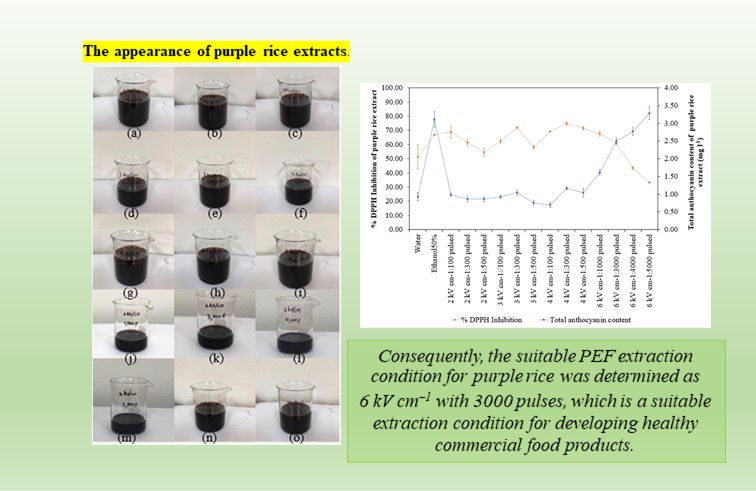Effect of pulse electric field assisted extraction on anthocyanin content and antioxidant activity of purple rice
DOI:
https://doi.org/10.55674/snrujst.v14i2.245162Keywords:
Purple rice, Anthocyanin, Antioxidant, Pulse electric fieldAbstract
Purple rice (Oryza sativa L.) is popular for planting and consuming in North and Northeast Thailand. The important pigment on the purple rice grain is anthocyanin which has high antioxidant activity. This research studied the effect of applying a pulse electric field (PEF) technique on the extraction of the total anthocyanin content, and the antioxidant activity of purple rice. The extraction treatment was divided into two levels of PEF [low and high PEF]. The low PEF treatment condition used low pulse numbers (0, 100, 300, and 500) at three levels of electric field intensity (2, 3, and 4 kilovolts / centimetres (kV cm–1) in 1 Hz). The high treatment condition used an electric field intensity of 6 kV cm–1 in 1 Hz with the pulse numbers of 1,000, 3,000, 4,000, and 5,000. The results indicated that a sample extracted with low PEF showed low anthocyanin content but high % of DPPH inhibition. In contrast, a high level of anthocyanin content and low % of DPPH inhibition were found in the high PEF extraction treatment. The result demonstrated that PEF technology did not cause a chemical change to anthocyanin but affected antioxidant activity. This effect was due to high energy and temperature generated in the high PEF treatment. The PEF technique has a benefit in decreasing the time required for the extraction process and does not negatively affect the anthocyanin extracted. The appropriate PEF extraction condition for purple rice was obtained at 6 kV cm–1 with 3,000 pulses, which provided an acceptable total anthocyanin content (2.50 ± 0.09 mg l–1) and was consistent with a percent inhibition of DPPH (60.97 ± 0.64). The results of this study have implications for the ongoing development and use of food-based products.
References
J. Phengrat, S. Jearakongman, Black glutinous rice: various benefits, composite thinking, enhancing Thai economic opportunities, Rice and temperate cereal crops annual conference 2009, Sea Breeze Jomtien Resort Chonburi. 9 – 11 June 2009, 325 – 342.
B. Rerkasem, S. Jumrus, N. Yimyam, C. Prom-u-thai, Variation of grain nutritional quality among Thai purple rice genotypes grown at two different altitudes, Sci. Asia. 41(6) (2015) 377 – 385.
C. Jansom, E. Skulkhu, V. Jansom, N. Lerdvuthisopon, K. Bhamarapravatana, Study on appropriate methods for extraction of antioxidant compounds from black glutinous rice, TMJ. 16(4) (2016) 625 – 633.
W. Jirarattanarangsri, P. Budprom, Effect of different processing on phenolic content, anthocyanin content, antioxidant capacity and consumer acceptance of black glutineous rice leaf tea, SWUJST. 9(17) (2017) 91 – 103.
Y.A. Purwestri, F.A. Susanto, A.N. Fauzia, Flowering gene expression in Indonesian long harvest black rice (Oryza sativa L. ‘Cempo Ireng’), AJCS. 13(6) (2019) 874 – 880.
R. Pratiwi, Y.A. Purwestri, Black rice as a functional food in Indonesia, FFHD. 7(3) (2017) 182 – 194.
D. Xue, M.M. Farid, Pulsed electric field extraction of valuable compounds from white button mushroom (Agaricus bisporus), IFSET. 29 (2015) 178 – 186.
N. Yang, K. Huang, C. Lyu, J. Wang, Pulsed electric field technology in the manufacturing processes of wine, beer, and rice wine: A review, Food Control. 61 (2016) 28 – 38.
Z. Liu, X. Zeng, D. Sun, Z. Han, R. M. Aadil, Synergistic effect of thermal and pulsed electric field (PEF) treatment on the permeability of SOYA PC and DPPC vesicles, J. Food Eng. 153 (2015) 124 – 131.
N.E. Darra, N. Grimi, R. G. Maroun, N. Louka, E. Vorobiev, Pulsed electric field, ultrasound, and thermal pretreatments for better phenolic extraction during red fermentation, Eur. Food Res. Technol. 236(1) (2012) 47 – 56.
T. Tonutare, U. Moor, L. Szajdak, Strawberry anthocyanins differentiation by pH differential spectroscopic method, Acta Sci. Pol. Hortorum Cultus. 13(3) (2014) 35 – 47.
M. Giusti, R.E. Wrolstad, Characterization and measurement of anthocyanins by uv‐visible Spectroscopy, CPFAC. (2001) F1.2.1 – F1.2.13.
S. Butsat, S. Siriamornpun, Antioxidant capacities and phenolic compounds of the husk, bran and endosperm of Thai rice, Food Chem. 119(2) (2010) 606 – 613.
K.M. Davies, An introduction to plant pigments in biology and commerce, in: K. Devies (Ed), Annual plant reviews vol 12: Plant pigments and their manipulation, CRC Press., Boca Raton, 2004, pp. 1 – 22.
P. Comuzzo, S. Voce, C. Grazioli, F. Tubaro, M. Marconi, G. Zanella, M. Querzè, Pulsed electric field processing of red Grapes (cv. Rondinella): Modifications of phenolic fraction and effects on wine evolution, Foods. 9(4) (2020) 1 – 15.
N. López, E. Puértolas, S. Condón, I. Álvarez, J. Raso, Effects of pulsed electric fields on the extraction of phenolic compounds during the fermentation of must of Tempranillo grapes, IFSET. 9(4) (2008) 477 – 482.
T. Gachovska, D. Cassada, J. Subbiah, M. Hanna, H. Thippareddi, D. Snow, Enhanced anthocyanin extraction from red cabbage using pulsed electric field processing, J. Food Sci. 75(6) (2010) 323 – 329.
N. Lebovka, M. Bazhal, E. Vorobiev, Pulsed electric field breakage of cellular tissues: Visualisation of percolative properties, IFSET. 2(2) (2001) 113 – 125.
N. Lebovka, M. Bazhal, E. Vorobiev, Simulation and experimental investigation of food material breakage using pulsed electric field treatment, J. Food Eng. 44(4) (2000) 213 – 223.
E. Bozinou, I. Karageorgou, G. Batra, V.G. Dourtoglou, S.I. Lalas, Pulsed electric field extraction and antioxidant activity determination of Moringa oleifera Dry Leaves: A comparative study with other extraction techniques, Beverages. 5(1) (2019) 1 – 13.
S. Keawsa-ard, A. Dadookain, Appropriate extraction methods and conditions of antioxidant compounds in Longan, TSTJ. 28(11) (2020) 2052 – 2063.
S. Sirichokworrakit, H. Rimkeeree, W. Chantrapornchai, U. Sukatta, P. Rugthaworn, The effect of extraction methods on phenolic, anthocyanin, and antioxidant activities of riceberry bran, SSSTJ. 7(1) (2020) 7 – 13.

Downloads
Published
How to Cite
Issue
Section
License
Copyright (c) 2022 SNRU Journal of Science and Technology

This work is licensed under a Creative Commons Attribution-NonCommercial-NoDerivatives 4.0 International License.








